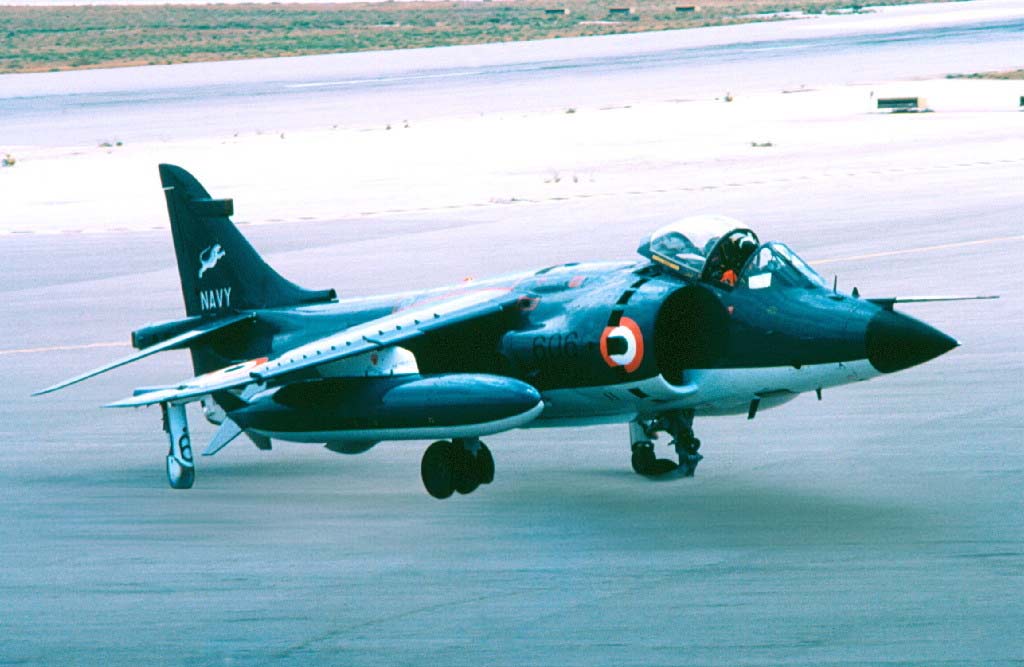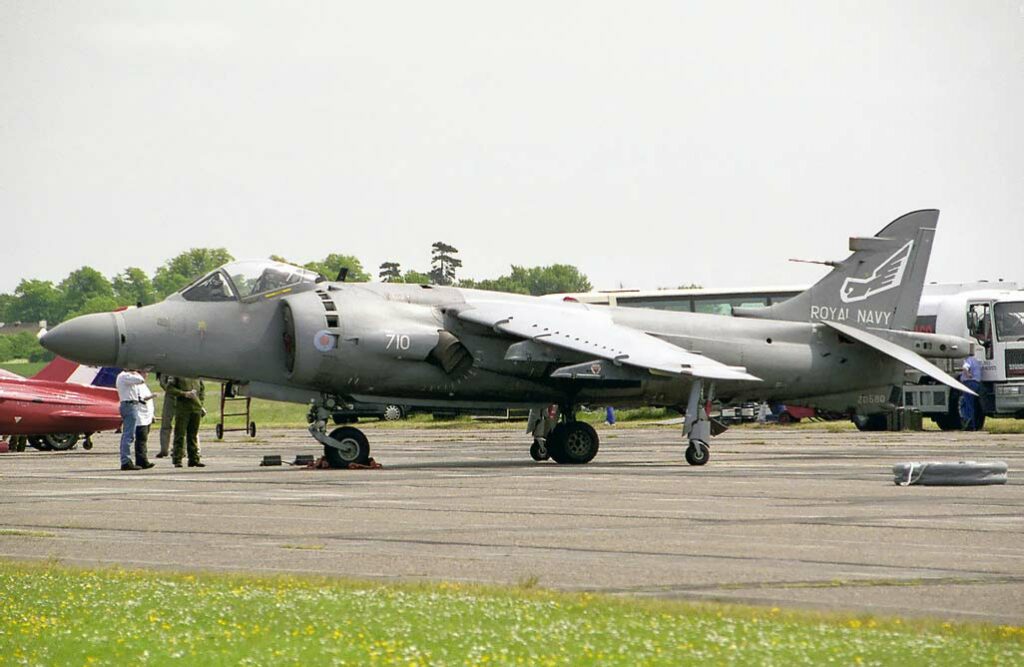British VTOL jet fighter, optimized for naval operations.
In brief
The British Aerospace (BAe) Sea Harrier is a naval short take-off and vertical landing (STOVL) jet fighter developed for the Royal Navy. A derivative of the Harrier GR3, the Sea Harrier features advancements including a redesigned fuselage, improved avionics, and naval capabilities. The aircraft is equipped with the Rolls-Royce Pegasus turbofan engine, which enables it to perform vertical takeoffs and landings—a critical feature for operations aboard aircraft carriers. Its armament includes air-to-air missiles and a cannon, enhancing its role in fleet air defense. First flown in 1978, it was primarily designed for patrol, reconnaissance, and strike missions.

History of the Development of the BAe Sea Harrier
During the Cold War era, the strategic landscape for naval forces was evolving rapidly, prompting the need for flexible and capable air defense systems. The British Royal Navy, recognizing the limitations of conventional aircraft aboard carriers, sought a solution that would enhance their operational versatility and effectiveness. This led to the development of a naval version of the successful Harrier jump jet, tailored specifically for maritime operations.
The BAe Sea Harrier program was initiated by the British government in the early 1970s. The main objective was to provide the Royal Navy with an air defense platform that could operate from aircraft carriers without the need for long runways, thereby significantly enhancing the fleet’s operational flexibility. The development was spearheaded by British Aerospace, and the prototype first flew on August 20, 1978.
Unlike its predecessor, the Sea Harrier was equipped with a more advanced navigation and attack system, specifically designed to cope with the maritime environment. The aircraft was not assigned a NATO reporting name, as its primary use was within the Royal Navy and not widely exported at the initial stages.
The Sea Harrier arrived at a time when naval conflicts were increasingly influenced by air power, and the capability to quickly deploy air assets was crucial. Its introduction into service in 1980 allowed the Royal Navy to project air power more effectively and with greater operational security. The aircraft’s ability to perform vertical and short take-offs and landings (V/STOL) meant that the British fleet could operate more flexibly in conflict zones, without relying heavily on large, vulnerable air bases or full-sized carriers.
Design of the BAe Sea Harrier
The BAe Sea Harrier’s design is marked by its innovative use of the Rolls-Royce Pegasus turbofan engine, producing 21,500 pounds of thrust, which allows for vertical takeoff and landing capabilities. The aircraft measures 46 feet in length and has a wingspan of 25 feet (14 meters by 7.6 meters). It is equipped with a high-mounted wing and a fuselage designed for optimal aerodynamic performance with a nose-down attitude during hover.
A key feature of the Sea Harrier is its use of four vectoring nozzles on the engine which direct the exhaust flow to control the aircraft during vertical maneuvers. This design supports operations from confined spaces like the decks of aircraft carriers and even in forest clearings, which would be impossible for conventional jets.
The Sea Harrier was equipped with advanced avionics including the Blue Fox radar, later upgraded to the Blue Vixen, which significantly enhanced its capability to detect and engage enemy aircraft at range. However, the integration of such sophisticated systems in a compact frame did impose maintenance and operational challenges, including high workload for single pilots and sensitivity to saltwater environments, which could affect longevity and reliability.
Despite these drawbacks, the Sea Harrier proved exceptionally beneficial in naval engagements, providing the Royal Navy with a significant tactical advantage. Its ability to quickly transition from hover to high-speed flight and vice versa allowed it to perform various roles, from fleet air defense to reconnaissance and strike missions.
Performance of the BAe Sea Harrier
The BAe Sea Harrier’s performance is characterized by its unique engine and design capabilities. Powered by a single Rolls-Royce Pegasus turbofan engine, the aircraft can achieve a maximum speed of approximately 735 miles per hour (1,182 kilometers per hour) and a service ceiling of over 51,000 feet (15,545 meters). Its operational range is about 540 nautical miles (1,000 kilometers), but it can be extended with in-flight refueling.
Comparing the Sea Harrier to other contemporary aircraft, such as the American AV-8B Harrier II, the Sea Harrier does not carry as heavy a payload but offers superior agility and shorter takeoff capability, crucial for operations from smaller carriers. The aircraft’s V/STOL capabilities also meant it could be deployed in areas where other fixed-wing aircraft could not operate, providing a strategic advantage in various conflict scenarios.
Variants of the BAe Sea Harrier
The Sea Harrier family includes several key variants, notably the FRS1 and the FA2. The FRS1 was the initial version equipped with the Blue Fox radar and was primarily used for air defense and reconnaissance. The FA2, introduced in the early 1990s, featured significant upgrades including the more advanced Blue Vixen radar, which improved target detection and tracking capabilities, and compatibility with the latest AIM-120 AMRAAM missiles.
These variants allowed the Royal Navy to maintain technological parity with adversaries by incorporating advanced electronic warfare and missile systems, enhancing the overall combat effectiveness of the fleet.

Military Use and Combat of the BAe Sea Harrier
The BAe Sea Harrier saw extensive military use, particularly in the Falklands War of 1982, where it played a critical role in achieving air superiority. The aircraft’s ability to operate effectively from carrier decks without the need for long runways allowed British forces to launch air operations despite being far from mainland bases. The Sea Harrier was used primarily for fleet air defense, intercepting Argentine aircraft in numerous engagements and significantly reducing the threat to British naval vessels.
During its operational lifetime, the BAe Sea Harrier proved to be a formidable asset in air-to-air combat, thanks to its advanced armament and unique flight capabilities. The aircraft was typically equipped with AIM-9 Sidewinder missiles, which are infrared-guided air-to-air missiles designed for short-range engagements. These missiles are highly effective in locking onto and tracking the heat signatures from enemy aircraft, making them ideal for the quick-reaction combat scenarios often encountered by naval aviators.
Additionally, the Sea Harrier was armed with a 30mm ADEN cannon. This cannon is a revolver-type autocannon known for its high rate of fire and substantial stopping power. Each round is significantly larger and more destructive than the standard ammunition used in lighter aircraft cannons, which allows the Sea Harrier to engage not only enemy aircraft effectively but also provide support against ground targets when necessary.
This combination of Sidewinder missiles and the ADEN cannon made the Sea Harrier particularly effective in its primary role as a fleet air defense platform. In combat, the flexibility to switch between missiles and cannon fire allowed pilots to engage a wide range of targets effectively, adapting to the immediacies of aerial or surface threats.
One of the most notable uses of the Sea Harrier in combat was during the Falklands War in 1982. The aircraft’s capabilities were put to the test in numerous dogfights against Argentine aircraft, often resulting in favorable outcomes for the British forces. The Sea Harrier’s performance in these engagements was a testament to its design philosophy, which balanced speed, firepower, and the unmatched ability to launch and recover from short runways or in vertical/short takeoff and landing scenarios.
The reliability and effectiveness of the Sea Harrier in these combat operations not only demonstrated its value as a military asset but also solidified its reputation among one of the most successful naval aircraft of its time. The operational success of the Sea Harrier, highlighted by its proficiency in air-to-air combat, played a crucial role in maintaining control of the airspace during naval operations and proved instrumental in the strategic outcome of conflicts like the Falklands War.
The Sea Harrier was not only used by the UK but was also sold to India, where it served as the backbone of the Indian Navy’s air wing until its recent replacement by the MiG-29K. The retirement of the Sea Harrier from active service in the Royal Navy came in 2006, when it was replaced by the more capable F-35 Lightning II, offering stealth capabilities and enhanced sensor integration.
Technical Conclusion
The BAe Sea Harrier represents a significant advancement in naval aviation technology, particularly with its V/STOL capabilities that allowed greater flexibility in aircraft carrier operations. Its service record highlights the effectiveness of such designs in extending the operational reach and tactical flexibility of naval forces, especially in conflict situations where air superiority and quick response times are crucial. The Sea Harrier remains a prominent example of innovative aircraft design tailored to meet specific military needs.
Back to the Fighter Jet section.